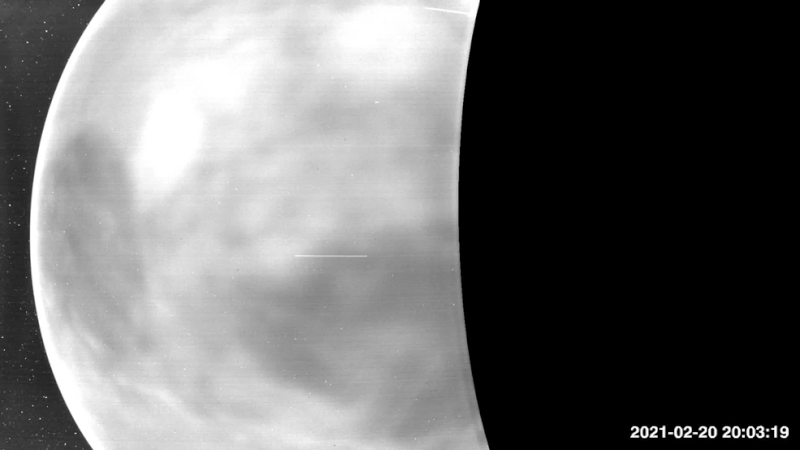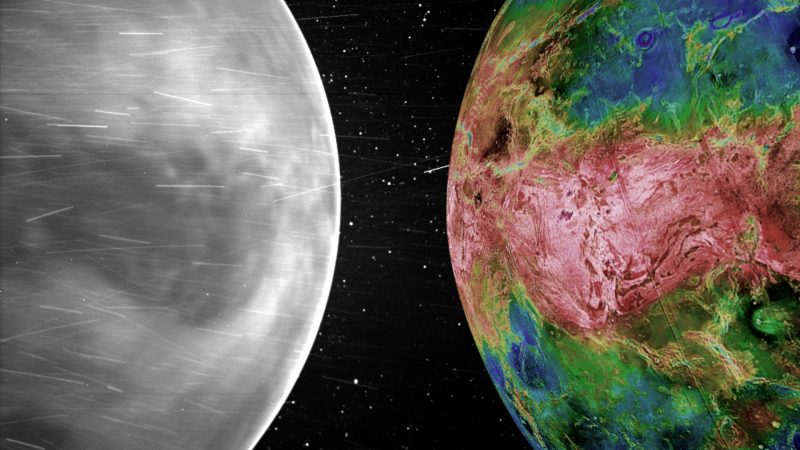NASA announced February 9, 2022, that the Parker Solar Probe has taken the first visible-light images of the surface of Venus from space. The probe, designed to study the sun, has used Venus in gravity assist maneuvers, and in doing so, has gotten a closeup view of the steamy, cloud-enshrouded planet. When it passed by the nightside of Venus in 2020, Parker’s Wide-Field Imager (WISPR) camera took images of the planet that revealed surface features. How could a camera in space see through Venus’ thick atmosphere? Venus’ surface is so hot that it glows in the longest wavelengths of light, bordering the infrared. The camera picked up this glow in the darkness of the planet’s nightside.
The objective of these flybys was to help the spacecraft get closer to the sun and measure the speed of the clouds on Venus. The view of Venus’ surface features was unexpected. Brian Wood of Naval Research Laboratory and lead author of the paper said:
The images and video just blew me away.
The scientists working with the Parker Solar Probe published their study in the peer-reviewed Geophysical Research Letters on February 9, 2022.
Seeing the surface of Venus
Venus has an aura of mystery because its clouds are so thick that they hide the planet under a veil. To further complicate matters, its temperature is so scorching that it’s inhospitable to spacecraft. The Russian Venera space probes are, to date, the only spacecraft to ever land on the surface of Venus, and their lifetimes were short. They lasted from 23 minutes to two hours, sending back images of the rocks and soil in their landing spot until succumbing to the high temperatures and pressures on the planet.
Parker’s 2020 flyby caught the scorching hot surface of Venus radiating in long wavelengths, like a thermal image. Wood said:
The surface of Venus, even on the nightside, is about 860 degrees [475 C]. It’s so hot that the rocky surface of Venus is visibly glowing, like a piece of iron pulled from a forge.
The scientists were so amazed by the images that they trained the WISPR camera on Venus during another flyby in 2021. This time, the spacecraft’s orbit lined up so that it could image the entire nightside of the planet.
The WISPR camera aboard Parker captured wavelengths of 470 to 800 nanometers. The visible range of light extends between 380 and 750 nanometers. Scientists used the WISPR images to make a video of the nightside of Venus. You can see airglow from the atmosphere, and underneath are dark and light surface features.

Parker’s view compared to radar
NASA’s Magellan mission in the 1990s used radar imaging to create the first detailed map of Venus’ surface. Japan’s Akatsuki mission added to our knowledge of Venus’ surface in 2016 with infrared imaging. Parker’s new images complement these maps and add a visible red portion to the data.
Parker showed that, as on Earth, higher altitudes are cooler than lowlands. The lowlands are brighter, while the higher elevations are darker.
The images will help scientists understand the makeup of the planet, because minerals glow at unique wavelengths when heated. Scientists also hope to understand the planet’s evolution and why it differs so much from Earth or Mars. In addition, the WISPR images may help explain how volcanoes played a role in making Venus the planet it is today.

Amateur astronomers can get involved
Venus is a popular target for amateur astronomers. Because it’s so bright, it’s an easy target for us on Earth to train our eyes, binoculars, telescopes and cameras at. Wood said:
Venus is the third brightest thing in the sky [after the sun and moon], but until recently we have not had much information on what the surface looked like because our view of it is blocked by a thick atmosphere. Now, we finally are seeing the surface in visible wavelengths for the first time from space.
And amateur astronomers may be able to take images of the surface of Venus, too. In fact, they may already have!
Seriously, you astrophotographers out there – and you know who you are – do truly INCREDIBLE work. We now know it's possible, so go get some images of Venus' nightside surface! You got this!????
— Karl Battams (@SungrazerComets) February 9, 2022
If you think you have a great photo of Venus, and perhaps even surface features from its nightside, submit it to EarthSky Community Photos.
Bottom line: The Parker Solar Probe has taken the first visible-light images of the surface of Venus from space. Amateurs may be able to take their own images of the Venusian surface on the nightside (unlit) portion of the planet.
Source: Parker Solar Probe Imaging of the Night Side of Venus
Read more: Parker Solar Probe: 1st spacecraft to touch sun
The post Surface of Venus revealed in 1st visible-light images from space first appeared on EarthSky.
0 Commentaires